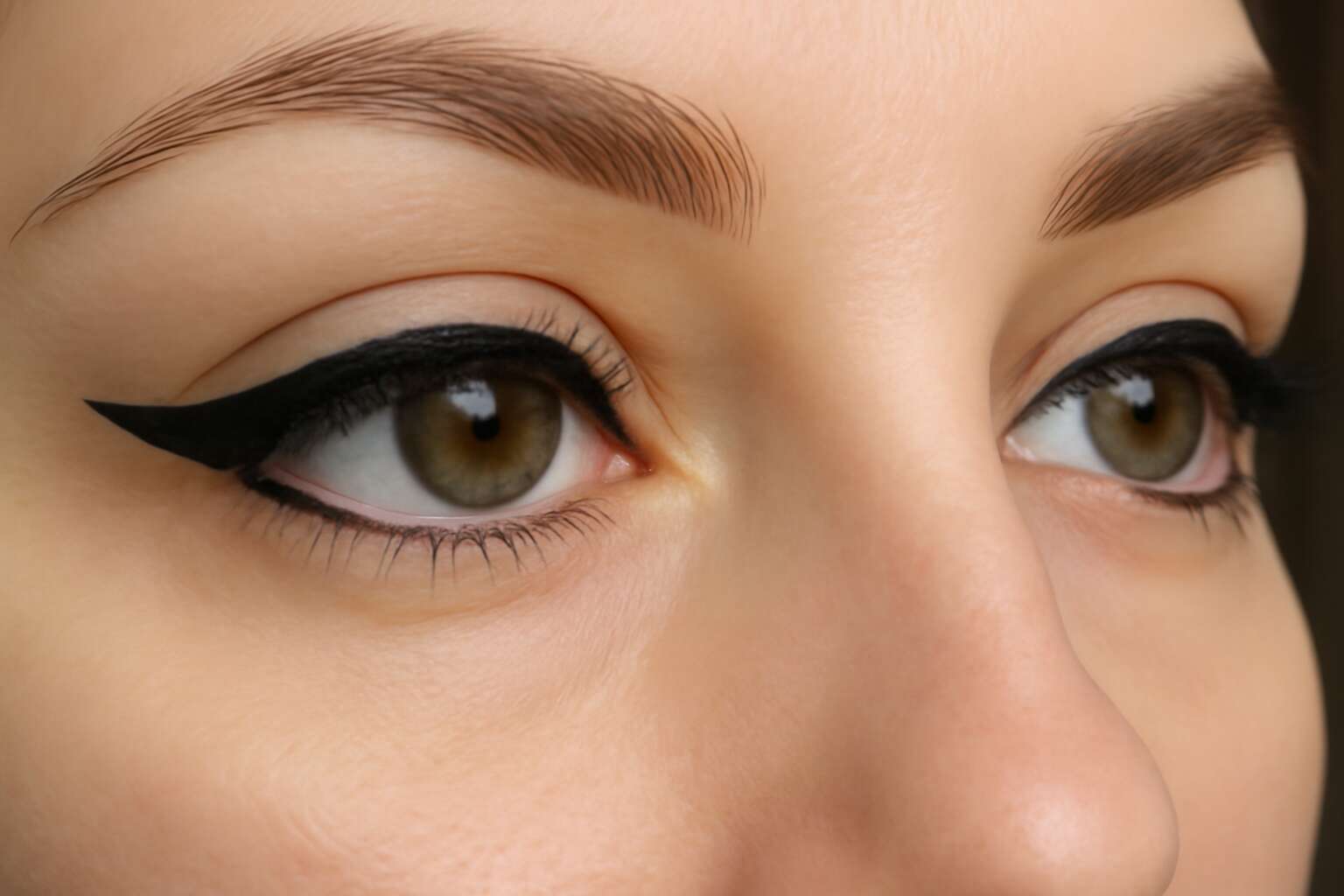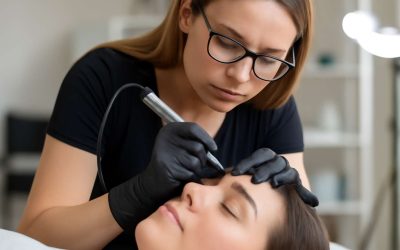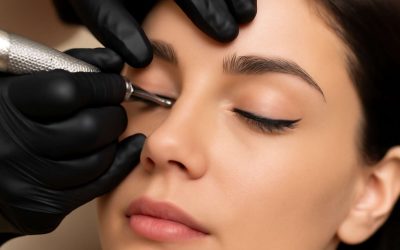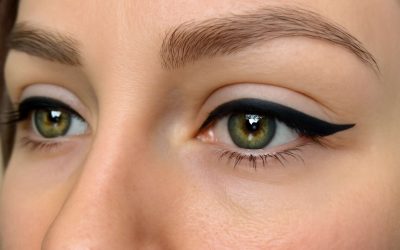Understanding Permanent Eyeliner
What Is Permanent Eyeliner?
Permanent eyeliner, a tantalising blend of artistry and science, holds the promise of effortlessly defined eyes that never smudge. But beneath its alluring veneer lies a question that lingers in the minds of many: is permanent eyeliner bad for you? This procedure involves depositing pigment into the delicate skin of the eyelids using tiny needles, creating a semi-permanent or permanent line that enhances natural beauty. While some see it as a revolutionary beauty shortcut, others are wary of potential risks lurking beneath the surface.
Understanding what permanent eyeliner entails is key to grasping its implications. The process is often compared to tattooing, but with specialised pigments designed specifically for cosmetic use. It’s essential to recognise that the pigments used are not standard inks; they are formulated to fade gradually over time, requiring touch-ups to maintain the desired look. However, the permanence of this procedure can sometimes be a double-edged sword, especially if adverse reactions occur or if the pigments contain undesirable components.
Types of Permanent Eyeliner Techniques
Understanding the diverse techniques used in permanent eyeliner application reveals much about its potential risks and benefits. There are primarily three prominent methods: the traditional eyeliner tattoo, the lash enhancement, and the shadowed or smoky look. Each of these techniques varies in complexity and depth, influencing how the pigment interacts with the delicate eyelid skin.
The tattoo method deposits pigment directly into the dermal layer, creating a bold, defined line that can last years. Conversely, lash enhancement subtly fills in the lash line, offering a more natural appearance. The smoky technique employs shading to produce a softer, more diffused effect.
While these methods might seem harmless, the question of “is permanent eyeliner bad for you” often hinges on the technique used. The choice of pigment, needle precision, and aftercare all play a role in whether the procedure turns out to be a beauty boon or a potential health concern.
Popular Reasons for Choosing Permanent Eyeliner
Understanding the allure of permanent eyeliner is like peering into a shadowed mirror—fascinating yet fraught with uncertainty. Many are drawn to its promise of waking up flawless, eyes perpetually accentuated, without the daily ritual of application. The reasons for choosing permanent eyeliner are as varied as the night sky—saving time, enhancing appearance, or simply seeking a bold statement that endures.
Yet, beneath its seductive veneer lies a question that whispers in the dark: is permanent eyeliner bad for you? The answer is nuanced, woven with threads of technique, pigment quality, and aftercare. For some, it offers a symphony of convenience; for others, a potential for complications that lurk unseen until shadows reveal their true nature.
A significant number opt for the lash enhancement or the smoky look, each choice echoing their desire for ethereal beauty—an eternal muse captured in pigment. But, as with all things shadowed in mystery, understanding the true risks requires a careful exploration of what lurks beneath the surface.
Potential Risks and Side Effects
Common Reactions and Allergic Responses
While many are captivated by the allure of permanent eyeliner, the reality is that this cosmetic procedure can carry potential risks. Unscrupulous salons or inexperienced technicians might inadvertently cause lasting damage, raising the question—is permanent eyeliner bad for you? The answer isn’t always clear-cut. Allergic reactions and adverse side effects can occur even with the most reputable clinics, especially if proper hygiene protocols aren’t followed.
Common reactions include swelling, redness, and itching around the eyes — symptoms that can escalate if an allergic response is triggered. In some cases, pigment migration or uneven lines might develop, creating an unsettling appearance that’s tough to correct. For those with sensitive skin or existing allergies, the risk of side effects increases significantly. It’s essential to understand that even a seemingly minor procedure can have serious repercussions, especially if the practitioner isn’t fully qualified or uses subpar pigments.
To minimise these risks, always scrutinise the credentials of your technician and inquire about the pigment composition. Remember, when considering permanent eyeliner, weighing the potential side effects against the aesthetic benefits is crucial. The question remains—is permanent eyeliner bad for you? It’s a decision that demands careful thought and thorough research.
Infections and Inflammation Risks
While the allure of waking up flawless is tempting, the lurking danger of infections and inflammation from permanent eyeliner cannot be ignored. Improper sterilisation of equipment or negligent hygiene protocols can turn this cosmetic enhancement into a nightmare. Bacteria and fungi can infiltrate tiny abrasions, leading to painful infections that may require medical intervention. In some cases, inflammation around the eyes becomes persistent, causing discomfort and even vision issues.
Serious complications can arise if the procedure isn’t conducted under strict sanitary conditions. Risk factors include not just infection but also the potential for granulomas—hard, swollen lumps that form as the body reacts to foreign substances. To prevent these hazards, it’s essential to scrutinise your technician’s credentials and ensure they follow rigorous sterilisation protocols. The question—is permanent eyeliner bad for you?—becomes even more pressing when you consider the possibility of infections and inflammation that could last for months or even years if mishandled.
Remember, a seemingly simple cosmetic procedure can carry significant health risks, especially if proper precautions aren’t taken. Infections and inflammation are silent threats that can turn a beauty enhancement into a medical ordeal. Always prioritise hygiene and professional expertise—your eyes deserve nothing less.
Long-term Skin Damage
While the allure of flawless, smudge-proof eyes might tempt many, the shadowy realm of potential risks lurks beneath the surface. One concern that often whispers in the back of minds is whether is permanent eyeliner bad for you. Beyond the initial glamour, long-term side effects can cast a pall over this cosmetic procedure.
Potential risks include not only the immediate aftermath but also lasting skin damage. Permanent eyeliner involves inserting pigment into the delicate skin around the eyes, which can sometimes lead to unforeseen complications. Over time, the pigment may cause irritation or cause the skin to react adversely, resulting in long-term skin damage that’s difficult to reverse. Additionally, poorly performed procedures might cause uneven pigmentation or fading, but more troubling are the deeper skin concerns. These can include scarring or pigmentation changes that persist years after the treatment.
It’s essential to recognise that the skin around the eyes is incredibly sensitive. If the pigments used are of inferior quality or if the technician neglects sterilisation protocols, the risk of adverse reactions increases dramatically. Sometimes, the body’s response to foreign substances can trigger granulomas—hard lumps that form as a defence mechanism—permanently altering the skin’s landscape. In essence, the question, is permanent eyeliner bad for you, is layered with complexities that extend beyond mere aesthetics. The possibility of long-term skin damage underscores the importance of choosing experienced professionals and quality materials for this irreversible beauty enhancement.
Impact on Eye Health
The allure of permanent eyeliner is undeniable, promising effortlessly striking eyes that stay flawless in every circumstance. Yet, beneath this shimmering surface lies a realm of potential risks and side effects that demand careful consideration. Many wonder, is permanent eyeliner bad for you? The answer isn’t simply black or white, but rather a complex tapestry woven with delicate threads of skin health and safety.
One of the most pressing concerns is the impact on eye health itself. When performed by untrained technicians or with inferior materials, the procedure can introduce bacteria or toxins that might lead to infections or inflammation. These conditions can cause redness, swelling, or even more severe complications if not recognised early. Moreover, the eye’s sensitive tissues can react unpredictably—sometimes developing granulomas or chronic irritation that persist long after the procedure.
Impact on vision is another risk often overlooked. Though rare, improper pigment placement or accidental penetration of the eye can cause irritation or damage to the cornea. For those considering this cosmetic enhancement, it’s vital to understand that the risks are not purely superficial. Ensuring the safety of your eye health requires meticulous attention to detail and choosing reputable professionals who prioritise sterilisation and high-quality pigments. Ultimately, the question, is permanent eyeliner bad for you, hinges on factors far beyond aesthetics—touching the core of your eye’s well-being and long-term safety.
Safety Considerations and Precautions
Choosing a Licensed and Experienced Technician
When considering permanent eyeliner, safety should be paramount. Selecting a licensed and experienced technician is crucial to minimise the risk of adverse reactions and long-term harm. A skilled professional will understand the intricacies of eye anatomy and use sterilised equipment, significantly reducing the likelihood of infections or inflammation. Remember, this procedure involves breaking the skin’s surface, so a lapse in hygiene or expertise can lead to serious complications.
To ensure your safety, always verify the credentials of your technician. Look for someone who is fully licensed and has a portfolio of previous work. An appointment with a seasoned professional not only offers peace of mind but also ensures the procedure is performed with precision and care.
- Check reviews and testimonials
- Confirm licensing and certifications
- Ask about sterilisation protocols
Importance of Proper Sterilization
In the realm of beauty enhancements, questions about safety linger like shadows—particularly, is permanent eyeliner bad for you? The truth is, beneath the allure of flawless, smudge-proof eyes lies a delicate dance with health risks. Ensuring proper sterilization isn’t just a procedural detail; it’s the guardian against unseen dangers. Unsanitary equipment can transform a routine session into a perilous encounter with infections or inflammation, threatening your eye health in ways you might never anticipate.
That’s why precautions are essential. A reputable technician will adhere to strict sterilization protocols, often employing single-use needles and sterilised tools to keep bacteria at bay. It’s not merely about aesthetics; it’s about safeguarding your vision and skin from long-term harm. When considering if permanent eyeliner is bad for you, remember that meticulous hygiene practices can make all the difference. Don’t be swayed by charming promises—demand transparency, proper licensing, and a clean environment, for your safety is the true beauty.
Patch Tests and Allergy Testing
In the shadowy intersection of beauty and health, questions about safety often linger like an unspoken warning—particularly, is permanent eyeliner bad for you? While the allure of flawless, smudge-proof eyes is undeniable, the potential risks demand careful consideration. One of the most critical safety considerations involves thorough allergy testing and patch tests prior to the procedure. These preliminary steps serve as silent guardians, revealing sensitivities that could otherwise ignite allergic reactions post-treatment.
To minimise adverse outcomes, strict precautions are essential. A reputable technician will perform patch tests at least 24-48 hours before the session, ensuring your skin’s unique response is understood. Remember, even a seemingly innocuous ingredient can spark unforeseen reactions; therefore, transparent dialogue about pigment composition and sterilisation practices is vital. When exploring whether permanent eyeliner is bad for you, never overlook the importance of comprehensive allergy testing—sometimes, the tiniest detail can safeguard long-term eye health and peace of mind.
Pre-procedure Consultation and Informed Consent
Safety considerations are paramount when contemplating whether permanent eyeliner is a good idea. Prior to any procedure, a thorough pre-procedure consultation is essential. This discussion should cover your medical history, skin sensitivities, and any current eye conditions. An informed consent process ensures you fully understand the potential risks involved, including possible allergic reactions and long-term skin effects. It’s crucial to ask your technician about their sterilisation practices and experience, as substandard hygiene can lead to infections.
To further safeguard your eye health, some clinics implement a series of precautionary steps, such as:
- Detailed allergy testing
- Patch tests conducted at least 48 hours before the procedure
- Clear communication about pigment ingredients and sterilisation protocols
These measures are vital in addressing the question of whether permanent eyeliner is bad for you. Remember, transparency and vigilance during the pre-procedure phase can make all the difference in avoiding unwanted outcomes and ensuring your safety.
Possible Complications and How to Mitigate Them
Uneven or Unintended Results
While many tout permanent eyeliner as the ultimate beauty shortcut, the reality can be far more sinister. Uneven or unintended results are a common concern that can turn your confident glow into a frustrating ordeal. Even with the most skilled technicians, unpredictable pigment distribution or fading can occur, leaving the eyes looking asymmetrical or blotchy. Such complications may not surface immediately, making them all the more insidious.
To mitigate these risks, meticulous consultation and precise pigment application are paramount. Sometimes, these mishaps stem from poor technique or inadequate pigment retention, which can be addressed through correction sessions. However, it’s vital to understand that these issues aren’t always entirely fixable, especially if the procedure was performed by someone lacking proper expertise. The key to avoiding these pitfalls lies in selecting a licensed professional and demanding transparency about their experience and previous work.
- If you notice uneven pigmentation post-procedure, avoid attempting to fix it yourself, as this could worsen the problem. Instead, consult your technician immediately to explore corrective options.
- Always insist on a patch test beforehand to identify potential allergic reactions, which can exacerbate uneven results or cause additional complications.
Color Fading or Changes Over Time
One of the less discussed but equally important concerns about permanent eyeliner is colour fading or changes over time. Many believe that once the procedure is done, it’s a set-it-and-forget-it situation. However, pigment retention isn’t always permanent in the way many expect. Exposure to sunlight, skincare products, and natural skin turnover can cause the colour to fade or shift, sometimes leading to uneven or dull-looking results. This is a natural process but can be distressing if not anticipated.
If you’re worried about how long the pigment will last or how it might change, it’s essential to choose a technician who uses high-quality pigments designed for longevity. Regular touch-up sessions can help maintain the desired look, but it’s equally important to remain realistic about potential fading. The question of is permanent eyeliner bad for you often relates to these long-term changes, making ongoing care and realistic expectations crucial factors in the decision-making process.
Laser Removal and Correction Options
While permanent eyeliner offers a tempting solution for those tired of daily makeup routines, it’s important to consider possible complications that can arise. In rare cases, individuals may experience persistent swelling, irritation, or even scarring if the procedure isn’t performed with meticulous care. These adverse reactions highlight the importance of selecting a technician who prioritises safety and uses sterilised, high-quality pigments.
In more serious situations, laser removal becomes a necessary, albeit costly, option. Laser treatment for permanent eyeliner involves breaking down pigment particles, allowing the body to naturally eliminate them. However, multiple sessions may be required, and the process can sometimes cause pigment scatter or uneven fading. For those seeking correction, professional guidance is vital to minimise risks and ensure optimal results.
To mitigate potential issues, some clinics offer comprehensive consultation, where they evaluate skin type and discuss realistic expectations. Remember, the question of is permanent eyeliner bad for you often hinges on how well the procedure is managed and the technician’s expertise. Prioritising safety today reduces the likelihood of regret tomorrow!
When to Seek Medical Advice
While the allure of effortlessly defined eyes is tempting, the shadow of potential complications lingers. Rare but serious reactions such as persistent swelling, irritation, or scarring can occur if the procedure isn’t meticulously managed. Recognising these risks underscores the importance of choosing a technician who prioritises hygiene and uses sterilised, high-quality pigments.
To mitigate such issues, it’s advisable to attend a comprehensive pre-procedure consultation. This session can help identify skin sensitivities and set realistic expectations, reducing the likelihood of dissatisfaction or adverse effects. If you experience unusual discomfort, heightened swelling, or visual disturbances after the procedure, seeking medical advice promptly is crucial. These symptoms may be signs that professional intervention is needed to prevent long-term damage or infection.
In some cases, laser removal becomes the only solution, but it’s an expensive and sometimes imperfect process. Multiple sessions could lead to uneven fading or pigment scatter, complicating correction efforts. Therefore, understanding when to seek medical advice ensures your safety and preserves the health of your eyes and skin, helping you avoid the question: is permanent eyeliner bad for you in the long run?
What the Experts Say About Permanent Eyeliner Safety
Medical Opinions and Studies
While the allure of perfectly defined eyes through permanent eyeliner is undeniable, medical opinions highlight the importance of understanding potential risks. Experts acknowledge that, when performed by trained professionals, the procedure can be safe; however, the question remains—is permanent eyeliner bad for you? Studies have shown that adverse reactions, although rare, can include allergic responses, infections, and even unforeseen long-term skin damage.
According to recent research, some ingredients used in pigment formulations may provoke allergic reactions or sensitivities in susceptible individuals. Furthermore, not all clinics adhere strictly to sterilisation protocols, increasing the risk of infection. It’s crucial to recognise that even with proper precautions, the permanent nature of the tattooed pigment can lead to unintended outcomes or colour changes over time. Medical opinions underscore the importance of comprehensive consultations and allergy testing to mitigate these concerns, emphasising that the safety of permanent eyeliner hinges on both practitioner expertise and patient awareness.
Opinions From Professional Artists
When it comes to the safety of permanent eyeliner, opinions from professional artists offer both reassurance and caution. Many skilled practitioners emphasise the importance of meticulous technique and high-quality pigments, yet even the most experienced can’t entirely eliminate risks. Expert artists often underline that the procedure’s success depends heavily on the technician’s expertise and adherence to strict sterilisation protocols.
While some professionals celebrate the aesthetic benefits, they also acknowledge that “permanent” doesn’t mean risk-free. In fact, many agree that the question of is permanent eyeliner bad for you remains nuanced. They highlight potential issues such as allergic reactions or colour changes that can occur long after the initial application. Some artists recommend careful pre-procedure consultations, including allergy testing, to mitigate adverse outcomes.
- Reactions to pigment ingredients
- Infection risks from inadequate sterilisation
- Unintended long-term skin effects
Ultimately, the consensus suggests that while permanent eyeliner can be safe when performed by qualified professionals, the decision must be approached with full awareness of possible complications. The glamour of defined eyes often masks the underlying complexities—reminding us that beauty and safety are intertwined in this delicate art form.
Regulatory Guidelines and Industry Standards
Regulatory guidelines and industry standards play a crucial role in ensuring the safety of permanent eyeliner procedures. Experts in the field agree that adherence to strict protocols can significantly reduce risks associated with the treatment. Governing bodies across various countries have established regulations that mandate the use of high-quality pigments and rigorous sterilisation practices, safeguarding clients from potential hazards.
For instance, many reputable organisations recommend that technicians follow a comprehensive framework, which includes:
- Standardised training and certification processes
- Regular inspection and accreditation of salons and clinics
- Use of approved, hypoallergenic pigments
These standards are designed to minimise complications such as allergic reactions, infections, or long-term skin damage. While the beauty industry continues to evolve, the consensus remains that only qualified professionals operating within recognised regulatory boundaries can deliver safe, high-quality permanent eyeliner procedures. This ensures that the question of is permanent eyeliner bad for you is addressed with the utmost care and professionalism, prioritising client safety above all else.
Alternatives to Permanent Eyeliner
Semi-Permanent and Temporary Options
For many, the allure of permanent eyeliner is tempting—lasting beauty with minimal daily effort. But is permanent eyeliner bad for you? While it offers a semi-permanent solution, some individuals prefer to explore alternative options that sidestep potential health concerns.
Semi-permanent and temporary options provide flexibility and peace of mind. These methods typically use less invasive pigments or dyes, reducing risks associated with long-term chemical exposure. For example, cosmetic tattooing or microblading can create a defined eye look without the permanence that might cause worry. Additionally, traditional makeup offers the ultimate control, allowing for experimentation with colour and style without any lasting commitment.
- Waterproof eyeliner pencils
- Gel or liquid eyeliners that can be easily removed
- Temporary tattoo liners designed for easy removal
Considering these alternatives can help you achieve stunning eye enhancements without the lingering doubts about whether is permanent eyeliner bad for you. Sometimes, choosing a less permanent route provides the perfect balance between beauty and safety.
Makeup Tips for Eye Enhancement
In a world increasingly obsessed with effortless beauty, the question of whether is permanent eyeliner bad for you often surfaces as a silent concern. While the allure of a flawlessly defined eye that requires no daily touch-ups is tempting, many individuals remain cautious about the long-term implications. Fortunately, a spectrum of alternatives exists, offering striking eye enhancements without the permanence that might evoke apprehension.
Temporary solutions such as waterproof eyeliner pencils and gel or liquid eyeliners are popular for their ease of removal and versatility. These options allow for spontaneous experimentation with colour and style, sparing users from the potential risks associated with permanent makeup. For those seeking a more artistic approach, temporary tattoo liners designed for easy removal provide a semi-permanent solution that balances beauty with safety.
Exploring these alternatives reveals a nuanced landscape where the desire for beauty does not have to compromise health—highlighting that sometimes, avoiding the question of whether is permanent eyeliner bad for you, is the wisest choice.
Risks and Benefits Comparison
In the shadowed corridors of beauty, the question lingers like a whispered secret: is permanent eyeliner bad for you? The allure of eternal definition tempts many, yet beneath its glossy veneer lies a labyrinth of potential perils. Fortunately, the realm of alternatives offers a safer passage—less invasive, yet equally compelling.
Temporary solutions, with their ephemeral charm, present an alluring escape from permanence’s dark embrace. Waterproof eyeliner pencils and gel or liquid eyeliners allow for spontaneous transformations, their ease of removal akin to shedding a worn cloak. For those who crave artistry without risking long-term damage, semi-permanent tattoo liners—designed for easy removal—offer a delicate balance between beauty and safety.
When comparing risks and benefits, these alternatives often reveal a less sinister side. They minimise the chance of allergic reactions, infections, or uneven results, all concerns often associated with the question of whether is permanent eyeliner bad for you. In this twilight zone of cosmetic choices, understanding the nuances can make all the difference—illuminating a safer path through the shadows of beauty obsession.




0 Comments